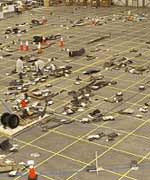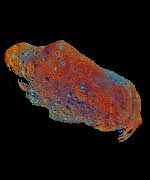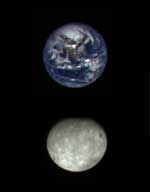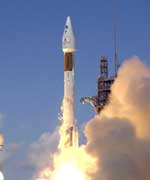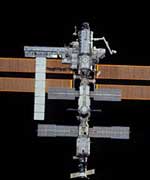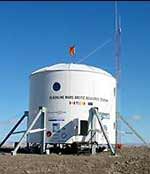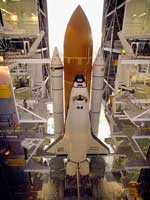
Image credit: NASA
2004-0519shuttle-sm.jpg view insert

Image credit: NASA
There have been several significant changes in NASA?s Space Shuttle return to flight effort since the last plenary meeting of the Return to Flight Task Group (RTF TG) in December. First, and most immediately, the schedule for the next launch was moved from September 2004 to March-April 2005. See Figure 1 below. This schedule change was prompted by three developments:
1. additional testing of the susceptibility of the Thermal Protection System (TPS), especially the Reinforced Carbon-Carbon, coupled with advanced analysis of the airflows around the Orbiter, External Tank (ET) and Solid Rocket Boosters indicated that the foam on a larger area of the ET should be stripped and reapplied;
2. some rudder speed brake actuators were discovered to have been incorrectly assembled during the original assembly over 20 years ago. Further, the gears in the actuators have generally suffered some damage with use and time. Therefore, all the actuators are being replaced or refurbished; and
3. design and building of a new camera/laser boom that would be used by the Space Shuttle?s robotic arm to help inspect for possible damage while in orbit.
This change in schedule means that NASA will have additional time to implement the Columbia Accident Investigation Board (CAIB) return to flight recommendations before return to flight. In many cases this change also allows expected plans to be at least partially implemented. For example, the CAIB called for a detailed plan to, among other things, establish an Independent Technical Engineering Authority?it is expected those plans will now be implemented, at least for the Office of Space Flight, before next year.
The expanded time before the next launch also allows NASA additional time to select and perfect methods of, for example, inspecting the TPS for damage. Since the loss of Columbia, NASA has been engaged in a wide-ranging search for corrective and preventive measures of all types. In some cases, the time is approaching when decisions must be made as to the most promising alternatives and resources focused on this smaller set of possibilities?the garden must be thinned. In this sense, the additional time until launch can be seductive and leadership will need to be exercised to sort the many options under consideration.
The second major change since December is the announcement of President Bush?s initiative, or vision, for the future of human space flight. The President proposed to utilize the Space Shuttle to finish the International Space Station (ISS) and then retire the Shuttle. In its place would be continued reliance on international partners to service the ISS as well as the possibility of private sector development of launch vehicles. During the next decade, NASA would also begin to develop the capability to return astronauts to the moon, establish a presence, and move on to explore Mars within the next 20 years.
While the President?s vision has obvious implications for the long-run use of the Shuttle, its effects on the return to flight efforts have not been fully examined. However, no matter how long the Shuttle is used in the future, it must first be safely returned to flight. Therefore, except for potential competition for human resources, the new program should have minimal impact on the actual return to flight activities and the implementation of CAIB recommendations. Third, the Task Group determined that the contingency of utilizing the ISS as a shelter for Shuttle Crew Contingency Support in the event of potentially catastrophic damage on the next flight, is becoming increasingly important in NASA?s decision making for return to flight. Therefore, the Task Group formally notified NASA of its intent to assess this capability much as if it were a CAIB recommendation.
Finally, the Task Group instituted a ?sub-panel? to examine the implications of the increased flow of data resulting from many of the CAIB recommendations and other return to flight initiatives.
The Task Group is encouraged by NASA?s progress since its last plenary in December. Throughout the organization, the people of NASA are engaged and dedicated to correcting the deficiencies that led to the demise of Columbia.
The RTF TG is conditionally closing out three CAIB recommendations. ?Closing out? a recommendation means that NASA has responded adequately to a specific CAIB return to flight recommendation. ?Conditionally? means that the close out is dependent on the delivery of final information and the assurance of NASA that it will keep the RTF TG up-to-date on any new developments pertaining to those recommendations. The three recommendations being conditionally closed out with this second interim report are:
3.3-1: Reinforced Carbon-Carbon Non-Destructive Inspection;
4.2-3: Closeout Inspection; and
6.3-2: NASA/National Imagery and Mapping Agency Memorandum of Agreement.
The Task Group will continue to monitor the implementation of these recommendations and NASA has agreed to notify the Task Group if there is any material change in status.
There has been substantial progress on virtually all of the 12 remaining return to flight recommendations. It is anticipated that several more recommendations will be substantially met by the time of the next RTF TG plenary in the summer.
One universal concern of the Task Group is the personnel requirements to meet the CAIB recommendations and return to flight. The various new organizations, from the NASA Engineering and Safety Center, to the Independent Technical Authority, to the Space Shuttle System Engineering and Integration Office all require talented staff drawn largely from the current NASA and contractor pool. At some point, the ability of the Space Shuttle Program to carry out its mission may be hampered by personnel shortages.
The most important work remains to be efforts to eliminate critical ascent debris. If it could be guaranteed that no critical debris would come from the ET, the immediate cause of the loss of Columbia would be rectified. But such a guarantee is impossible short of extensive testing in flight. Analytical and testing techniques will allow a level of comfort before launch and advances in Non-Destructive Inspection techniques may add to confidence. However, statistically significant results verifying ET debris conditions may not be accomplished even by the end of the Shuttle Program.
As such, on-orbit inspection and repair remain necessary to reduce the risk to future flights. Should one or both of these capabilities not be fully developed by the anticipated date of return to flight, the ability for the crew to await a rescue mission at the ISS will become an important consideration for the next launch.
Original Source: Stafford-Covey Second Interim Report (PDF)
